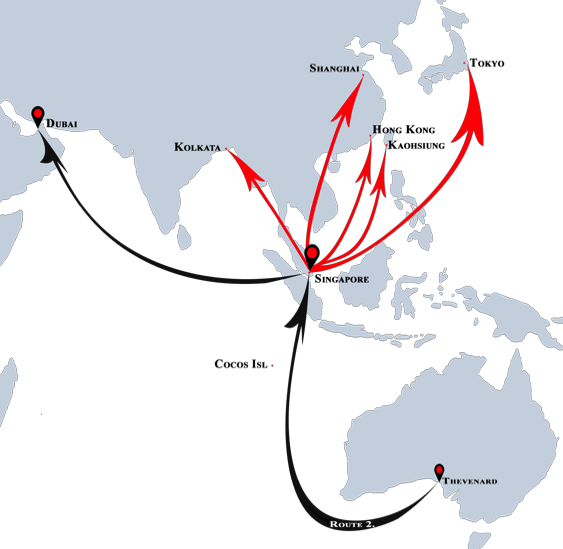SEALINK ROUTES
PELAMIS SEALINK
Pelamis is proposing to establish regular sea freight services between South Australia, and the international trading hubs of Singapore and Dubai. Using Refrigerated Cargo Ships, the service is to replace the broken air-bridge for the transfer of live seafood into Asia. The service is designed to be a reliable, and cost effective freight service for South Australian live seafood exporters, to enable them to relink with traditional freight services out of Singapore and Dubai.
Pelamis Group has extensive knowledge of shipboard live tanking installations, and have applied this in designing a live tank system for installation into each vessel, that has a capacity to carry up to 150-ton of live product per voyage.
The link is designed to reconnect multi South Australian seafood suppliers with their traditional markets, open up new markets, at a viable and sustainable cost. It is not just a freight service, but a new route to market for their high value product.
THE SERVICE
It is proposed to operate three Ships, over two different sea-routes. The first route between Thevenard (SA) and Singapore, and the second between Thevenard (SA) and Dubai. The schedule would provide a bi-weekly service to Singapore, and tri-weekly service to Dubai.
Pelamis ships have the capacity to carry Live, Chilled and Frozen product. Live product in bulk holding tanks for live seafood. Frozen product at either -25’C or ULT -60’C. Chilled product as required. The ships are fast cruising at 18-20 knots, making voyage time to Singapore 8-days. With each vessel having the capacity to carry between 150 and 180-ton of live seafood, depending on the species mix being carried. Thus, giving a total route to market for 300+ ton of live seafood per month.
MV SOUTHERN SUN
VESSEL TYPE: Refrigerated Cargo Ship
CLASS: Set Norske Veritas (DNV) (GL number 21770)
TONNAGE: 7,743 GT / 3,726 NT / 7,726 DWT
LENGTH: 131.27 metre LOA
Speed: 18.0-kn ave / 20.5 max
ROUTE 1: THEVENARD/SINGAPORE/THEVENARD
ROUTE 2: THEVENARD/SINGAPORE/DUBAI/THEVENARD


ROUTE 1.
SOUTH AUSTRALIA TO SINGAPORE
PORT: THEVENARD 2-days
LEG 1: THEVENARD to SINGAPORE 8-days
PORT: SINGAPORE 2-days
LEG 2: SINGAPORE to SURABAYA 1-day
PORT: SURABAYA 2-days
LEG 3: SURABAYA to THEVENARD 6-days
VOYAGE DURATION: 21-days
ROUTE 2.
SOUTH AUSTRALIA TO SINGAPORE TO DUBAI
PORT: THEVENARD 2-days
LEG 1: THEVENARD to SINGAPORE 8-days
PORT: SINGAPORE 2-days
LEG 2: SINGAPORE to DUBAI 8-days
PORT: DUBAI 2-days
LEG 3: DUBAI to THEVENARD 12-days
VOYAGE DURATION: 34-days
LIVE SEAFOOD
It is proposed to carry Southern Rock Lobster, Abalone, Mussels, Pacific Rock Oysters alive in tanks. Priority would be for South Australian product, with any surplus space made available to interstate suppliers. Each vessel has the capacity to carry between 150 and 180-ton of live seafood, depending on the species mix being carried. A total route to market for 300+ ton of live seafood per month.
CHILLED PRODUCT
In addition to the live seafood, the service will also carry chilled product, either in internal holds or as deck cargo in TEU’s. Each vessel has the capacity to carry between 1,000 and 1,500-ton of product, depending on the product mix being carried. A total route to market for 3,000+ ton of chilled product per month.
Upon arrival in Singapore the live seafood is “packed-out” on board, as per the suppliers directions, to local markets, or to join airfreight services out of Singapore or Dubai to complete the delivery to their customers.
By switching from airfreight to sea freight to transfer product to Singapore, live seafood suppliers effectively shift their pack-out operations from Australia to Singapore. Cutting air travel time to market by around sixty percent, and removing the reliance on “third parties”. This delivers a strong, fresh product directly to the end market. In effect suppliers regain control of how their product gets to market, reduces mortalities and cuts cost to market.
NEW MARKETS
Pre-coronovirus Seafood exports had become focused on the China market. Price and demand superseded the need to expand into new markets. Post-coronovirus, the China market has all but shut down, the supply chain to Asia has been broken, and the Australia/China relationship has soured; there is now an urgent need to find new markets for South Australian seafood.
The Sealink service to Singapore and Dubai opens up new markets in Asia and Europe, that were previously too far away to safely send live product into. It also means that the “second tier” seafood such as oysters and mussels, is no longer cost-prohibited from access due to high freight costs.


